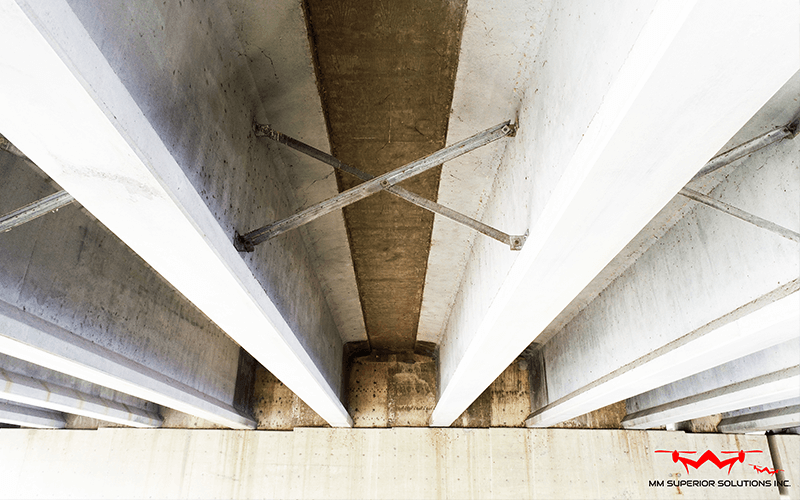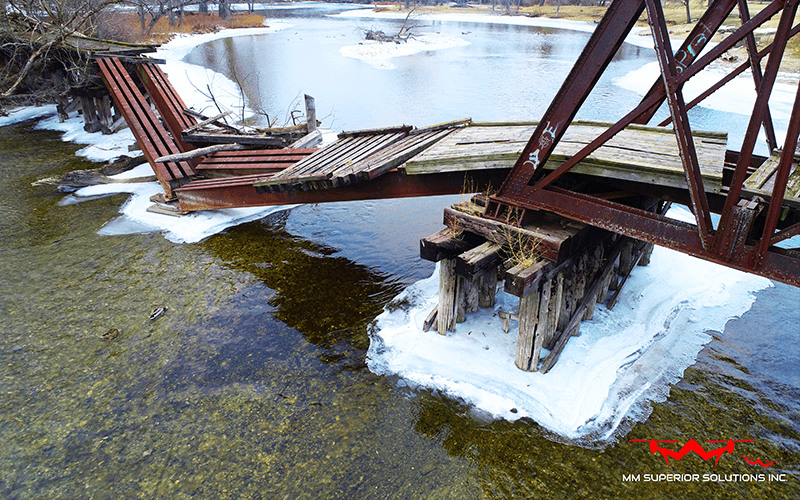DOT Bridge Inspections
MM Superior Solutions offers drone-based bridge inspection services that can help you get the most accurate information possible about the condition of your bridge.
With our experienced pilots and advanced equipment, we can quickly and safely gather data about the bridge’s condition, helping you make informed decisions about how to best maintain and protect your infrastructure.
Our drones are used in conjunction with drone inspection software in artificial intelligence, 3D imaging and analytics to enhance their capacity to gather a vast range of data and identify flaws.
Drones vs Manual
Traditional bridge inspections are typically done by a team of engineers who walk the bridge and take measurements. However, this process can be time-consuming and dangerous. Even with the right equipment, manual bridge inspections can’t always provide accurate data due to areas that are hard to access.
Drones offer a more efficient and safer alternative to traditional bridge inspections. By using drones, engineers can get a comprehensive view of the bridge’s condition without having to climb up ladders or walk on shaky bridges. Additionally, because drones can fly close to the bridge, they can gather more accurate data than manual inspections.
How Drones are Used for Inspections
Reducing Hazards for Workers and the Public
Drones are often used for bridge inspections because they can safely reach and fly close to difficult-to-access areas and are much more affordable.
Additionally, by using drones instead of workers, companies can reduce the number of hazards present during an inspection. This is especially important when working on bridges that carry a lot of traffic. They eliminate risks such as falls, car accidents, and dangers associated with adverse weather conditions and the effects of natural disasters.
In-depth data collection of bridge status
Drones can quickly and easily gather accurate data about a bridge’s condition. Proximity sensors, HD and thermal cameras allow for data collection of bridge status that is second to none. Bridge inspectors can now have a much better understanding of the condition of a bridge with just a few drone flights.
How Drones are Used for Inspections
Reducing Hazards for Workers and the Public
Drones are often used for bridge inspections because they can safely reach and fly close to difficult-to-access areas and are much more affordable.
Additionally, by using drones instead of workers, companies can reduce the number of hazards present during an inspection. This is especially important when working on bridges that carry a lot of traffic. They eliminate risks such as falls, car accidents, and dangers associated with adverse weather conditions and the effects of natural disasters.
In-depth data collection of bridge status
Drones can quickly and easily gather accurate data about a bridge’s condition. Proximity sensors, HD and thermal cameras allow for data collection of bridge status that is second to none. Bridge inspectors can now have a much better understanding of the condition of a bridge with just a few drone flights.
Rapid Identification of Faults and Defects
The ability to rapidly identify faults and defects is a critical factor in deciding whether to close a bridge. By using drones for inspection, this information can be gathered much more quickly and effectively than with traditional methods.
Our drones also make it easier to document analysis reports. When using drone inspection software like BlueVu, the documentation of findings and defect records can be reduced and simplified.
3D Modelling
Drones are not just used for inspections, but also for 3D modelling and mapping. This technology is extremely beneficial for creating a detailed, accurate map of a bridge. Mapping can help engineers better understand the condition of a bridge and plan repairs or updates.
Cost Reduction
Overall, drone-based bridge inspection is much more cost-effective than traditional methods. Not only are drones faster and safer to use, but they also require less labour. With the right equipment, a single drone can easily complete the work of several workers.
Drones also help to minimize the dangers linked with conventional methods by reducing the need to close a bridge, saving expenses and time for drivers.



